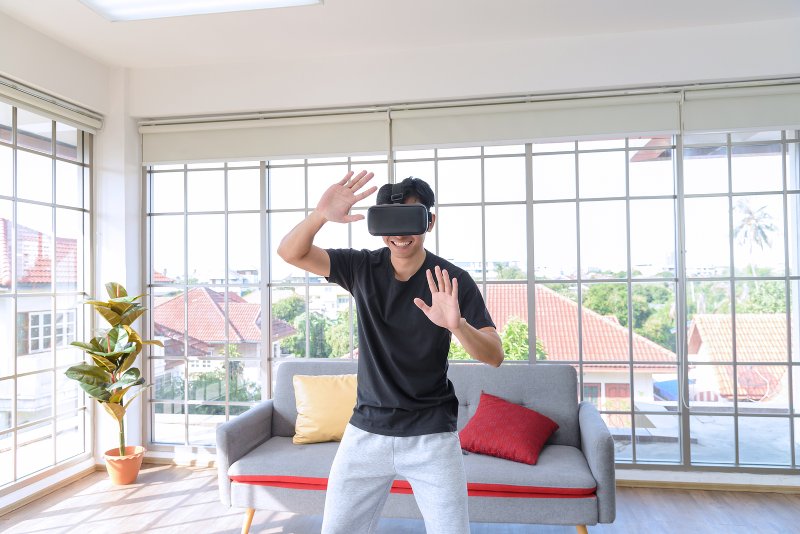
If you love to play VR games, the idea of having a whole room dedicated to virtual reality might be one of your greatest dreams. Nothing beats the idea of having a whole room for VR because we understand how messy things might become when using the living room or another part of the home as a makeshift VR space.
It is an open secret that to experience the highest level of immersion from virtual reality, adequate space is often required. Furthermore, playing a virtual reality game requires moving around within a given space. Having enough space to move around brings real satisfaction to the user. Hence, getting adequate space should be one of the topmost priorities for VR enthusiasts.
We understand it is quite a challenge to set up a virtual reality room. From not knowing the appropriate room size, type of VR equipment to purchase, and even being in the dark about what your budget size should be.
In this article, we will discuss everything you should know about setting up a dedicated VR room and the best hardware to have for your virtual reality room. We will as well share some useful tips about creating a standard virtual reality room.
CONTENTS:
- Selecting the best headset for a VR room
- Best desktop PCs for VR room
- Devices and Accessories needed for a VR room
- Tips for creating a virtual reality room
- What kind of space do you need for the HTC VIVE
- What do you need for the Oculus Rift
Selecting the best headset for a VR room
If you are thinking of setting up a VR room, it is likely you already own a virtual reality headset and a compatible PC. If you don’t have any of these gadgets, we still got you covered! We will briefly highlight the options of VR headsets available and their pros and cons. This guide would assist you in making the right call about the headset to choose.
If you are building a VR room from scratch, you need to have the right set of fully capable devices to run every sort of VR-related program. The following are the VR headsets available for purchase today:
- HTC Vive
- Oculus Rift
- Google Cardboard
- Samsung Gear VR
HTC Vive
HTC Vive is one of the most advanced VR headsets that are available for purchase today. This headset can read a user’s head movement by using an accelerometer and a MEMS gyroscope. A few sensors are integrated with this headset to communicate with hand controllers and also to track the movement of users. These sensors equally allow for the simulation of hand movements in real-time.
Pros
- Great immersive experience
- The package includes motion controllers and external sensors
- 360-degree motion
Cons
- Not budget-friendly
- The tethered headset makes whole-room VR tricky
- Not portable requires a lot of space and sensors
Bottom line
If you are planning to set up a VR dedicated room, it’s a VR headset worth having.
Oculus Rift
This is undeniably one of the most popular virtual reality hardware available. This headset is built with “constellation technology”. It’s a trailblazer in the VR world. The headset makes use of LEDs and sensors for tracking and real-time simulations. This VR headset allows users to walk around within the virtual environment unhindered. You can get this headset at a fair price of $845.
Pros
- Great immersive experience
- Works with Oculus and SteamVR platforms
- It includes both conventional gamepad and Oculus Touch controllers
Cons
- Needs four USB ports (three 3.0, one 2.0) to fully function
Bottom line
Another wonderful virtual reality hardware that is worth having in a VR dedicated room.
Google cardboard
Google cardboard is another virtual headset you could buy to set up your VR room. However, this headset comes with a myriad of limitations. Unlike the HTC Vive and the Oculus Rift, it can’t be used to create a simulation. To get the best out of this VR headset, a very good phone is often required. It has lag issues and prolonged use of this headset results in motion sickness.
Pros
- Budget-friendly
- Compatible with most Android and iPhones
Cons
- Quality of experience based on user’s smartphone
- No best practices for app development
Bottom line
The least effective VR headset on our least. If you are very low on funds, it’s a decent option.
Samsung Gear VR
This headset is an upscale version of google cardboard. To use this VR headset, a good smartphone is required. The drawback is that; It is only compatible with Samsung smartphones, which means prospective buyers have limited options. The edge it has over the Google cardboard is that it has sensors for tracking. It has a better immersion experience than Google cardboard.
Pros
- A headset is not dependent on the phone’s internal sensors to generate images
- Extremely portable
- Relatively cheap
Cons
- Motion sickness
- Headset only compatible with Samsung smartphones
- Poor battery life
Bottom line
If you are new to virtual reality, it is advisable to start with this VR headset or the Google cardboard.
Best desktop PCs for VR room
| IMAGE | PRODUCT | DETAILS | |
|---|---|---|---|
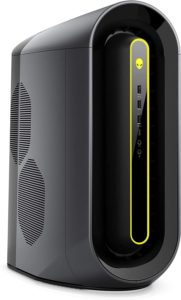 |
Our #1 Choice
Alienware Aurora Ryzen Edition R10 |
|
Check on Amazon |
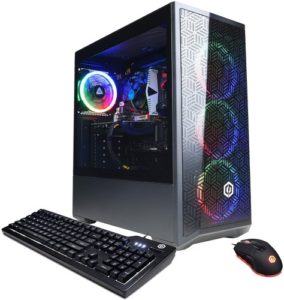 |
CyberpowerPC Gamer Xtreme VR |
|
Check on Amazon |
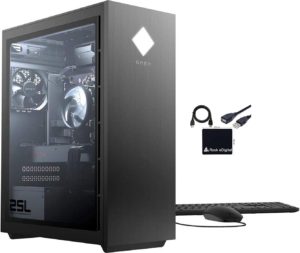 |
2021 HP OMEN 30L Gaming Desktop |
|
Check on Amazon |
A good desktop PC with powerful hardware allows users to fully enjoy the virtual reality experience. Most popular VR headset manufacturers have hardware requirements for their products. For example, the minimum hardware requirements for HTC Vive is as follows:
- Processor: Intel Core i5-4590/AMD FX 8350 equivalent or better
- GPU: NVIDIA GeForce GTX 1060, AMD Radeon R9 480 equivalent or better
- Memory: 4 GB RAM or more (8 GB RAM is recommended)
- Operating system: 64-bit Windows 10 or Windows 7 SP1
- SteamVR app: Version 1533664367 or later
While the minimum hardware requirements for Oculus Rift is as follows:
- Operating system: 64-bit Windows 10.
- CPU: Intel Core i3-6100 / AMD Ryzen 3 1200, FX4350 or greater.
- RAM: 8GB.
- GPU: NVIDIA GeForce GTX 1050Ti / Radeon RX 470 or greater.
- USB Ports: 1 USB 3.0.
Using compatible and suitable PC hardware heightens the level of immersion experienced. We have compiled a list of the best desktop PCs that are suitable for VR dedicated rooms.
- Alienware Aurora Ryzen Edition R10
- Cyber power Gamer Xtreme VR
- 2021 HP OMEN 30L Gaming Desktop
1. Alienware Aurora Ryzen Edition R10

This desktop PC is one of the high-end processor computers you can have for your VR room. It is specifically designed for powerful and efficient gaming performance. This desktop gives you the power to explore something different with its 16-core 3rd generation AMD Ryzen processor. It is equally the first Alienware machine to feature PCI-Express 4.0 technology, which doubles the bandwidth available to graphics cards for enhanced overall gaming performance.
This product also features an industrial design with an improved airflow pattern. This pattern ensures airflow moves more fluidly and efficiently to reduce CPU temperatures. The lower temperature automatically means performance with more stability and higher overclocking, which results in higher frames per second while gaming. The specifications are as follows:
- Operating System: Windows 10
- Processor: 4.4 GHz ryzen_7_3700
- RAM: 16 GB
- Graphics Card Ram Size: 8 GB
- Number of USB 2.0 ports: 6
- Number of USB 3.0 ports: 8
This desktop PC provides everything you need to enjoy VR games. Although it doesn’t come cheap at $1,961. This product offers real value for money. It is arguably the best VR desktop you would find.
2. CyberpowerPC Gamer Xtreme VR

This desktop PC is fully optimized for gaming and specially designed for the HTC Vive and the Oculus Rift. The high-performance CPU gives the computer the needed power to function at a high level. The high-speed memory and large hard drive give the CyberpowerPC gamer Xtreme VR all the space needed to focus on gaming.
This PC has been tested to meet the requirements to support VR gaming for both the HTC Vive and the Oculus Rift VR. This computer is designed with an inbuilt Intel core i5 processor which delivers an incredible performance. This computer allows users to freely multitask applications faster. It delivers maximum performance.
This computer is equipped with GeForce GTX 16 series graphics cards which are powered by Pascal to deliver up to 3x the performance of previous generations graphics cards with a lot of new gaming technologies. GeForce GTX GPUs and NVIDIA game-ready drivers deliver the fast performance and low latency required for an amazing gaming experience. The specifications are as follows:
- Operating system: Windows 10 Home
- Processor: 2.9 GHz core_i5
- RAM: 8 GB DDR4
- Hard Drive: 500 GB Flash Memory Solid State
- Graphics Coprocessor: NVIDIA GeForce GTX 1660
- Card Description: GeForce GTX 1660 Super
- Graphics Card Ram Size: 6 GB
- Number of USB 2.0 Ports: 2
- Number of USB 3.0 Ports: 6
Are you planning to get a suitable gaming PC? This supercomputer ticks all the boxes. It is fast and provides incredible performance. It is fairly priced at $940. A great computer to have for your VR-dedicated room.
3. 2021 HP OMEN 30L Gaming Desktop

This product is the largest and equally the most powerful gaming desktop. This new gaming laptop is specially built for VR games. It has one distinct advantage over its competitors; it runs quietly and smoothly. It runs your favorite games in high and clean resolution. It is equipped with an Nvidia 3080 GPU, Intel Core i9 processor, and 32 GB RAM, this computer has virtually everything you can ask for!
This desktop uses a custom-made ATX motherboard which is typical for this type of product. The circuit board is matte black which gives it a nice design. It is equipped with overclocking features thanks to its high-end processor.
It has a modern look, RGB lighting, and different components from Cooler Master, Western Digital, and HyperX. All these make it an awesome PC to have for your VR room. The following are the specifications of the HP OMEL 30L Gaming Desktop:
- Operating system: Windows 10
- Processor: Up to 10th Gen Intel Core i9-10900K
- RAM: Up to 64 GB
- Graphics Card: Up to Nvidia GeForce RTX 3090
- Storage: Up to 2 TB SSD + 2 TB HDD
- Ports: USB-A, USB-C, SD card, 3.5 mm audio, Ethernet, DisplayPort, HDMI
- Size: 17.1 x 16.6 x 6.7 inches
Although this PC might be a little bit expensive, it’s a desktop PC worth buying for your VR space.
Devices and Accessories needed for a VR room
Some devices and accessories are needed in a VR dedicated room to make the immersive experience unforgettable. The following is the list of some of these accessories:
- Swivel chair
- Bluetooth headphones
- Headset cover
- Voice assistance
- Grip socks
Swivel chair
Do you have a VR room? You need a swivel chair! To explore the virtual reality world, a comfortable chair improves the overall experience of a VR user. One of the features of a good swivel chair is that it should provide good lumbar support and a comfortable recline.
Also, a good swivel chair should have adjustable height arms and seat arms. A swivel chair in a VR room should be lightweight and swivel tilt. The swivel tilt works by reducing the pressure on the back and allows for more mobility.
Bluetooth headphones
A good sound experience is crucial to the level of immersion experienced while playing virtual reality games. A standard VR room should be equipped with a good pair of Bluetooth headphones.
Bluetooth headphones are better than those with cables because you don’t want to get entangled with different types of cable while being immersed in virtual reality.
You might find the Koss Porta Pro really useful. This headphone is lightweight, cheap and it has a protective case. However, you should go for compatible headphones with your VR headset.
Headset cover
Over the years, one of the biggest complaints from VR enthusiasts is the lack of comfort a VR headset provides. For most people, spending as little as 10 minutes playing VR games can result in face soreness leaving the user feeling unmotivated after playing.
With the headset cover, it minimizes the pressure on the face. Fortunately, you can get these foam padding for HTC Vive, Oculus Rift, and Samsung Gear VR. You can purchase a headset cover for just $29.
Voice assistance
Switching your headset on and off can be very stressful. Especially if all you want to do is to check the time or your inbox. If you’ve got Alexa in your VR room, the routine of switching on and off would no longer be an issue. All you need to do is to ask out loud, then Alexa obeys your voice commands promptly.
Having a voice assistant installed in your VR room saves you time from repetitive tasks. You can buy Amazon’s digital assistant for about $180.
Grip socks
If you are a virtual reality game enthusiast, you need a pair of grip socks when playing VR games. There’s a high risk of slipping and falling when playing VR games with regular socks. Grip socks provide more stability for VR game players. Grip socks have little rubber nubs that provide traction.
Tips for creating a virtual reality room
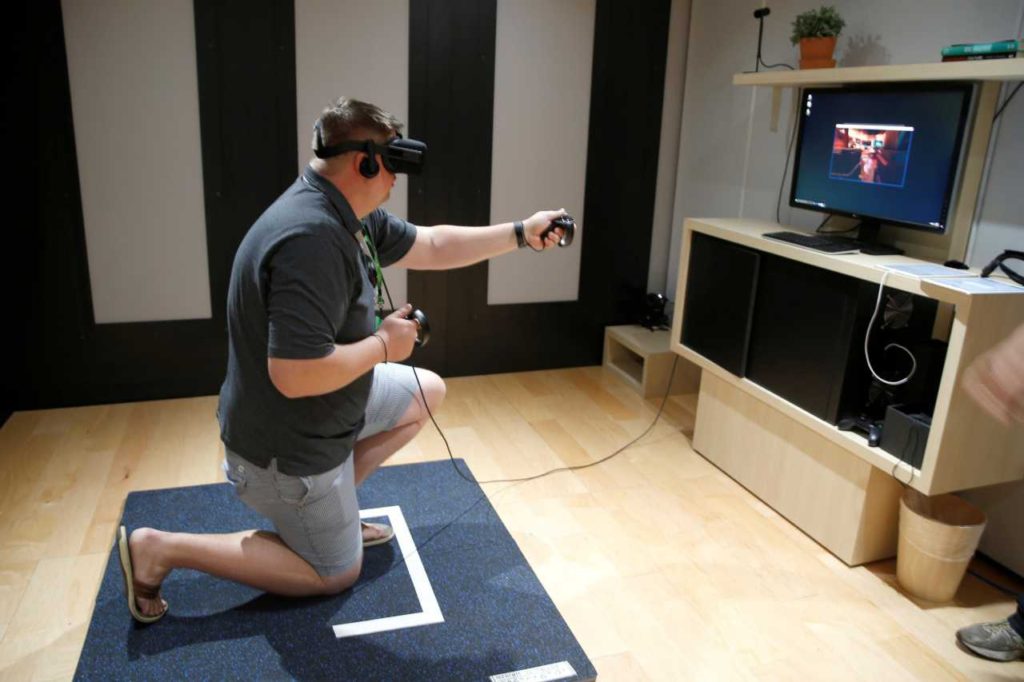
After you have bought a VR-capable PC and a VR Headset, it is time to open the question you will probably ask yourself: Where should I put this thing?
If you are really into VR, we are sure you don’t want just to sit or stand in one place while playing your favorite game, you want to move around and have a full experience of the Virtual Reality. So, to heighten the feeling of immersion, you will need a Room-scale VR. A Room-scale VR means that the VR you are using is configured for the size of your available play area to provide you with an environment where you can move around freely, with no fear of hitting your knee or elbow on something.
For the more dedicated VR gamers, the best solution would be to set up a VR Room, a permanent play space where you can freely interact with the immersive VR environment.
How much space do you really need?
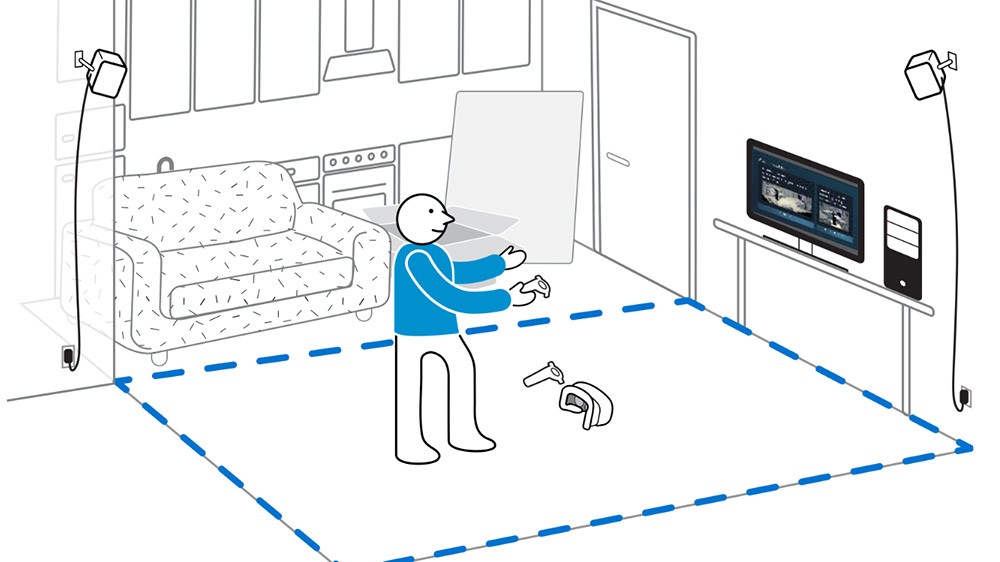
When it comes to the amount of space you will need to enjoy your adventure in the Virtual World, it depends on the type of VR experience you want to achieve.
If you require just a seated variant of the VR experience, you don’t have to have much space. A seated VR experience doesn’t need more space than you already have on your desk chair or, maybe a sofa. But, if you want a standing VR experience, the minimum space area you will need is 3 feet by 3 feet. Remember that is just the minimum of required space, so the best would be to go slightly above the minimum required space, only to be sure you can fully enjoy the Virtual Reality.
For the ones who want to take the VR experience to the next level, a VR room is the best decision. The VR Room will give you the freedom of movement. Whether you want to walk, jump or run, with theVR room, you do not have to fear that you will bump into your coffee table.
The minimum recommended area for a Room-scale VR is 1,5 by 2 meters, but just like with the seating VR experience, this is only the required minimum. So, for the highest level of immersion, and if you have enough space, go as big as your room will allow you to go.
Are High Ceilings a Must When it Comes to VR?
There are no exact requirements in height when it comes to VR tracking stations, but it depends if you are using HTC VIVE tracking stations of the Oculus Rift VR system.
The requirements for HTC VIVE tracking stations is that the height should be just above your head, or ideally, more than 2 meters altogether. Unlike the HTC VIVE, the Oculus Rift VR system doesn’t have any requirements with regards to the height of the base station. This is because the Oculus Rift VR system doesn’t allow a room-scale experience. The expected height of the base for the Oculus Rift is the same as the height of your PC monitor.
Because you do not have to stick to a certain height with the VR tracking stations, you could go on your own and mount the tracking sensors on your ideal height. You can use camera tripods to test out various heights and locations for the tracking stations and sensors before you place them permanently.
Essential Things to Note When Setting up Your VR Room
When setting up a VR Room, the most crucial thing to consider is safety. Even though the HTC VIVE and the Oculus Rift both have a warning system that will alert you when you are too close to the boundaries of your play area, that doesn’t mean you should entirely rely on that.
Your play area should be as clear from obstacles as possible. Move everything out of your play space that could be considered a potential danger. When you are in the Virtual World, you are blind to the real world, so everything that can come into your way, like a table, bed, or chair, could cause an injury.
The obstacles in your play area aren’t just a potential danger for you, they also can affect the tracking sensors.
If you have a low ceiling fan in your VR Room, you should consider moving it away from your VR area, or replacing it with a non-glass light fixture. So if you do not want to hit the ceiling fan with your hand, or if you are flexible, your leg, you should move that thing away from your safe area. If the ceiling fan is on the right spot in the room, it can actually add to the immersion of the game you are playing.
The boundaries of your play space shouldn’t be at the very end of your play area, they should be set slightly smaller. When everything is set in the right place, you don’t have to worry about safety, and you can fully enjoy the Virtual World.
Some items that have a reflective surface, like mirrors or windows, can cause VR tracking interference. These items can interfere with the motion tracking of the VR HMD and controllers, so the best would be to remove them from your VR room. If some of these items aren’t movable, for example, you can’t just move your windows to another place, you should at least cover them with some fabric so that they don’t reflect light that is generated by the motion trackers.
This doesn’t mean that you should remove everything that has a reflective surface form the room. You surely will notice if something is interfering with the motion trackers, so if no problem occurs, you do not have to move anything.
Another vital thing you should keep in mind when it comes to setting up your VR room is cable management. There is nothing more annoying than tripping on an HDMI cable and breaking your VR immersion. So if you do not want a cable to come in your way, you should make sure that the wires which connect your Computer to the Head Mounted Display are as unobtrusive as possible.
To avoid tripping on wires, you can create an elaborate ceiling-mounted cable management system, or you can move your PC into a closet or into another room.
Soon, the cable-tripping problem will become a part of the past because there are already some variations of wireless cord replacement you can buy.
VR Room Network Requirement
If you are looking into playing a multiplayer VR game, you will have to make sure you have a stable and reliable network connection.
The recommended network requirement for multiplayer gaming in VR is a wired Ethernet connection. If you don’t have Ethernet cable connection available, you can instead use a Powerline Networking solution. The Powerline Networking uses your home’s electrical wiring to carry network signals.
If this also isn’t an option, you can go with a Wireless signal. When using Wi-Fi, make sure that the Wi-Fi signal comes from your house and that it’s strong and stable.
What flooring do you need for your VR Room
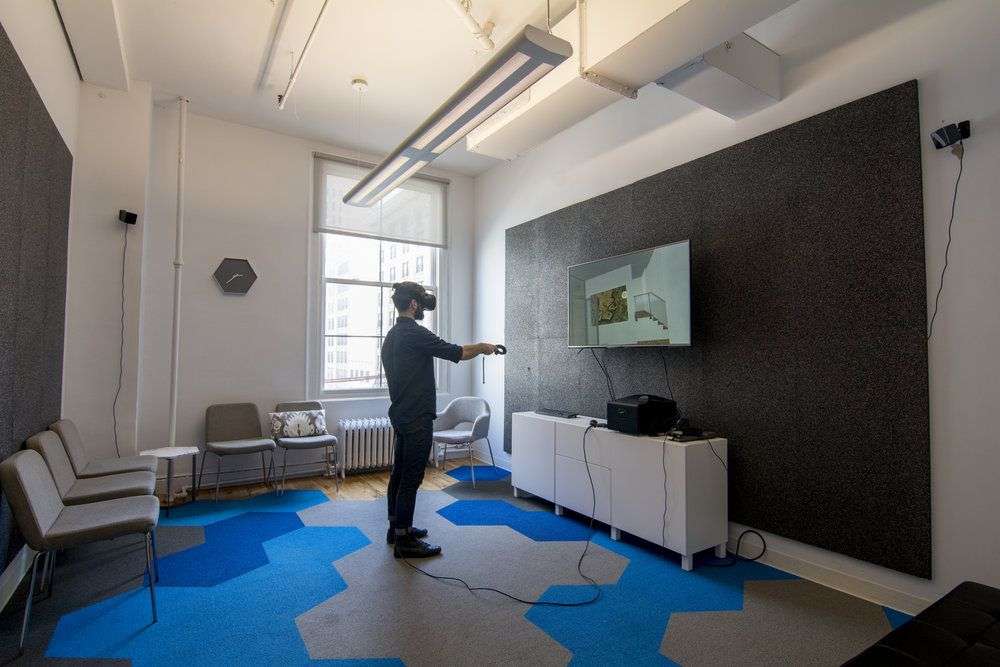
When designing a VR room, the floor should be on top of the list. Because in the Virtual World there are plenty of opportunities for exercise, and some of the games you are playing will require jumping, crawling, running and shooting, you surely want to have a comfortable surface where you can perform all of these maneuvers. The best solution would be to get interlocking foam tiles, but a carpet with a thick pad underneath will be just as right.
The flooring is also important because it can help you to add an additional safety feature. This safety feature is called VR warning track. The warning track should serve you just like a baseball player in the stadium, it will tell you if you are about to step out your safety area.
To create the safety area, you should use foam padded tiles in the center of the play space, while the edges of your play space should have another flooring. If you do not want foam-padded tiles, that is ok, you can use a carpet, just make sure that the rug in the center of the play area has a different texture.
By the change of the floor textures, you will know when you are about to step out of your safety zone, even though you are in the Virtual World, so the warning won’t affect your immersion.
Create a VR Spectator Area
If you have some extra space in your VR room, you could create a VR spectator area.
Virtual reality must not be a personal and solitary experience, it could be a social event as well. If you want to enjoy the Virtual World while spending time and having a fun time with your friends, a VR spectator area will be a great amusement.
There are many VR multiplayer games on the market in which one person can play the game using the VR headset, while other people can assist them in the game by using a controller or a mouse and keyboard. If some of your friends are not into playing games, that is not a problem, they can watch the whole action on a second monitor. Most games, even if they don’t offer a co-op mode, offer the possibility to mirror the VR headset’s output onto a second monitor where your friends can see everything you see in the Virtual World.
When creating a VR spectator area, you should make some kind of safety barrier between the play area and the spectator area. Organize the VR room so that the spectators can see both you playing and the second monitor, but also make the play zone safe in order not to crash into the second monitor or your friends.
Once all is set up correctly, invite your friends over, and the VR party can begin.
Add Some Fine Details in Your VR Room
Once your VR area is all set and safe, it is time to add a personal touch to the VR room.
In some VR games, you will have to use real-world props like gun stocks for virtual sniper rifles, driving wheels or golf shafts. If you don’t want to store all these props in a closet where no one can see them, you could make a shelf on the wall where you can display all these props. This is a good idea because it will add a personal note to the room, add to the aesthetic of the room, and the items can easily be removed when needed.
Another good idea would be to buy or build a controller stand where all your controllers, headphones, and headsets will always be in one place.
What kind of space do you need for the HTC VIVE
The HTC VIVE offers a SteamVR lighthouse tracking system. This tracking system uses a pair of emitters to coat the room in lasers. With the help of the lasers, the HTC VIVE offers you a precise tracking of your movements.
The HTC VIVE’s lighthouse sensors should be placed so that there is no risk of occlusion. So, if you have reflecting surfaces in your VR room, you should consider moving them to another place so that they don’t affect the tracking system. The windows in the VR room should be covered with some kind of fabric, to avoid interference with the light sensors.
The sensors can be mounted on a bookshelf or on the wall so that they are placed in opposite corners of the room.
The base station of the HTC VIVE should be positioned above head height, ideally, 2 meters altogether. It can cover a play area od 4 by 3 meters.
It would be good to use foam padded tile in the center of the play zone, so that you, even if you are in the Virtual World, can feel when you are about to step out of the safety zone in the real world. Instead of foam-padded tile, you can use a regular rug that has a different texture than the rest of the floor. The change in the surface of the floor will alert you when you are about to cross the line of safety. Foam padded tiles or a rug is also a good idea because these kinds of floors aren’t slippery, so you do not have to worry that you will slip and fall while playing a game in VR.
Your VR room should be cleared out of any furniture that you do not need in there. So, all the chairs and sofas that you don’t need should be moved to another place.
It would be good to make room on your desk for the controllers and all the other stuff you will need when playing a game in the Virtual World. While you are playing a game in a dark room, it can be tricky from the first to find something that you might need while playing. So, all the items that you will potentially need in the game should be placed on your desk, so that you don’t have to interrupt your immersion in the Virtual Reality to search for those items.
What do you need for the Oculus Rift
Unlike the HTC VIVE, the base station of the oculus rift is designed so that the base station should be at the same height as your Computer monitor. But, there are no strict rules when it comes to the height of the base station. You can experiment with the height of the base station so that you alone can decide what the ideal height for you is.
Oculus Rift uses a pair of 1080×1200 displays that are being refreshed at 90 Hz. This is not an easy task for your Computer because it will have to render two monitors with 90 frames per second to give you a pleasant experience.
For the Oculus Rift you will need the following things: a system with two or more USB 3.0 ports, Windows 7 or newer, you need to have all the latest drivers for your video card, the PC should be compatible with HDMI 1.3 video output, and it will need at least 8GB + RAM, a processor with the equivalent of Intel i5-4590 or higher. Also take note that you will need a graphics card that is, at least, an equivalent of the NVIDIA GTX 1070 – AMD RX 5700 XT.
When it comes to the kind of space, you will need for the Oculus Rift, it is practically all the same just like with the HTC VIVE. Safety goes first. Make sure your VR room has enough space so that you can more freely, remove any obstacles from the play zone that can be a potential danger, and keep the room in order. You are free to add some personal touches to the VR room if you want to.
And this brings us to the end of the article. Let us know what you think about setting up a VR dedicated room. Is it a good idea? What are your experiences? Let us know in the comments below!
YOU MIGHT ALSO LIKE:
The Future – VR, But What is Virtual Reality?
Oculus Quest Review – A true Game-Changer
HTC Vive Review – An Amazing Entry Into Virtual Reality


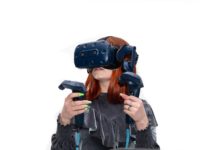
No Responses